![]()
![]()
![]()
Use LEFT and RIGHT arrow keys to navigate between flashcards;
Use UP and DOWN arrow keys to flip the card;
H to show hint;
A reads text to speech;
128 Cards in this Set
- Front
- Back
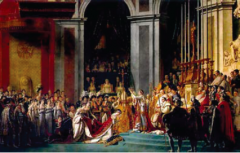
|
French Society: Coronation of Napoleon
-middle class became more empowered because they had access to making more money |
|
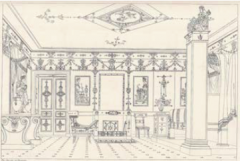
|
Recueil de Decorations Interieures-the book they published
-Percier and Fontaine -Portfolio of Interior Decoration -significant because it was published in other countries which influenced the Empire style all over Europe
|
|
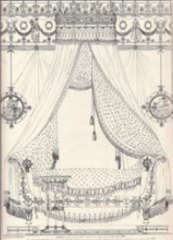
|
Percier and Fontaine
-developed a new style for Napoleon -Napoleon was powerful and he wanted to show the greatness of the French culture to the rest of the world
|
|
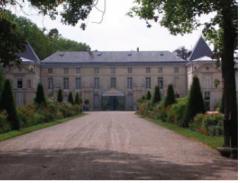
|
Chateau de Malmaison
-Percier and Fontaine developed the interiors
|
|
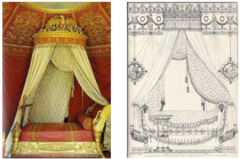
|
Josephine's Bedroom, Malmaison
-French Empire -1812 -Bed by Jacob Desmalter |
|
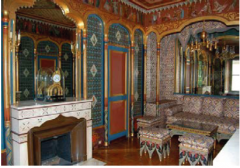
|
Turkish Boudoir
-Example of exoticism -Hotel de Beauharnais -Charles Percier and Pierre-Francois-Leonard Fontaine |
|
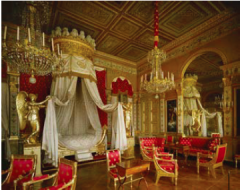
|
Empress Marie-Louise's State Bedroom
-Napoleon's second wife's bedroom -French Empire -Chateau de Compiegne -Dubois and Redoute design |
|
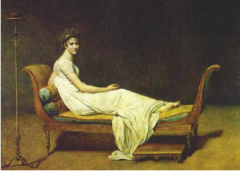
|
Recamier Couch
-influenced by Roman Lectus -Jaques Louis David -"Madame Recamier" -1800 |
|

|
Empire Bed Source: Roman bronze double-backed Lectus
-inlaid silver and copper -curved back |
|
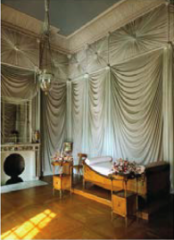
|
Bedroom of Queen Luise
-German Greek Revival with French Empire Influence -Designer: Karl Friedrich Schinkel -Charlottenburg Palace, Berlin
|
|

|
-Prince of Wales motif -Typical German Greek Revival forms and motifs: classical columns, pediments, Greek key acanthus leaves, palmettes, lyres, urns, hearts and arrows, and stylized Prince of Wale Motif (three feathers held by ribbon or crown) |
|
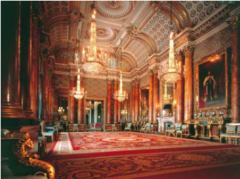
|
Blue Drawing Room
-Buckingham Palace, London -John Nash-George the 4th favorite architect -English Regency |
|
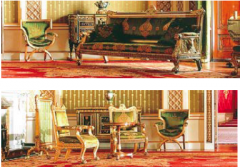
|
Green Drawing Room
-Buckingham Palace, London -English Regency |
|
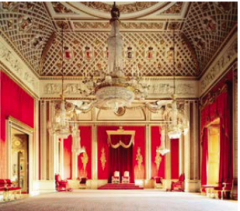
|
Throne Room
-Buckingham Palace, London -English Regency -vivid crimson wallpaper -John Nash |
|
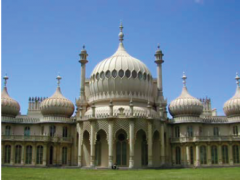
|
The Royal Pavilion at Brighton
-English Regency -interested in exotic design: political interest because they were colonizing different countries around the world, which created many influences from these countries -John Nash |
|
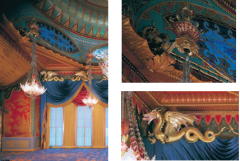
|
The Music Room
-The Royal Pavilion at Brighton -heavily draped windows with multiple layers -English Regency -John Nash and Frederick Crace |
|

|
English Regency Armchair
-exaggerated cruves on arms -influenced by klisomos-splayed legs -Thomas Hope -London |
|
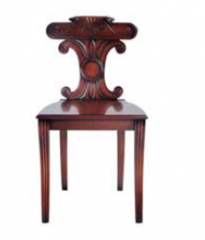
|
English Regency
-Mahagony Hall Chair -London -Thomas Hope -Influenced Biedermeier designs |
|
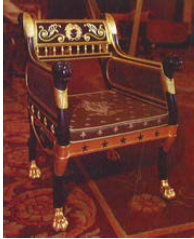
|
English Regency Carved and Gilt Armchair
-French Empire influence -London -George SMith |
|
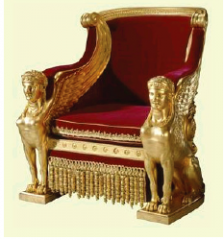
|
Council Chair
-Tatham, Bailey, and Sanders -English Regency |
|

|
Chaise Longue
-very popular form -London -English Regency |
|
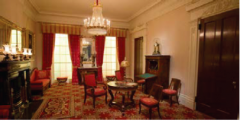
|
American Greek Revival Parlor
-American Empire Furniture -Duncan Phyfe-furniture maker -pediments had leaf forms which were folded at the corners and made of plaster -Metropolitan Museum of Art |
|
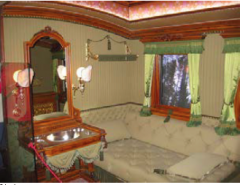
|
Railways: Empress Elizabeth's (Austria) Rail Car |
|
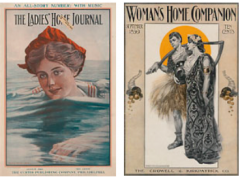
|
Magazines, Ladies Home Journal
-1892 -Women's Home Companion -1899 |
|
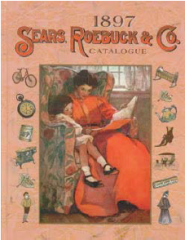
|
Mass Merchandising
-Montgomery Ward -1872 -Sears Robeck 1897 |
|
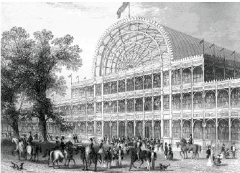
|
The Crystal Palace
-London -Joseph Paxton |
|
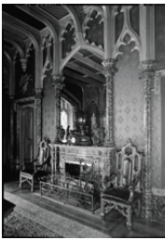
|
Victorian Period Commonalities
-Clients want novelty, fast and inexpensive -Connoisseurship lacking -History is a standard value -revival styles imbued with moral attributes -rarely historically correct -defined gender roles: women make homes places of culture, education and taste |
|
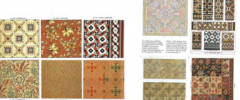
|
Victorian Residential Floors
-large patterns -Wall to wall machine made brussels, wiltons, administers (pile weave) ingrain (flat weave)
|
|
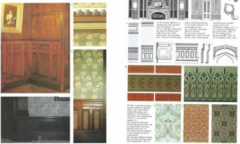
|
Victorian Residential Walls
-division of space on walls -walls often defined by wallpaper rather than, or in addition to, millwork -typical components were wainscot, chair rail, field, picture rail, frieze, crown molding, and ceiling |
|
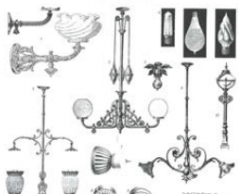
|
19th C lighting progressed from candle to gas to electric
-candle to gas to electric -gas lighting brought significantly more light to interiors -typically chandeliers suspended from ceiling medalions |
|
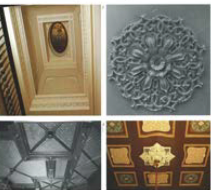
|
Victorian Residential Ceilings
-medalions -crown molding in plaster, plaster medalion at center |
|
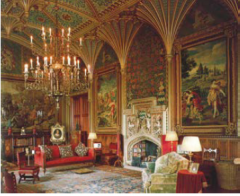
|
Eastnor Castle
-Gothic elements, but more ornate -gilded fan motifs on ceiling -Herfordshire, England -Gothic Revival -Ecclesiastical forms applied to Victorian residential Interiors |
|
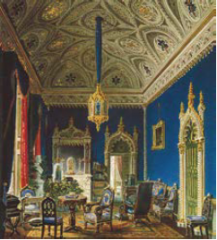
|
Design for a Gothic Revival Salon
-watercolor -paris |
|
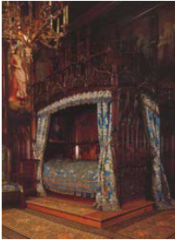
|
Ludwig II Bedroom
-Neuschwanstein Castle -Gothic Revival -Bavaria |
|
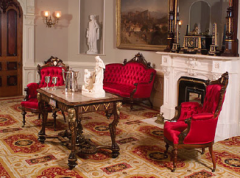
|
Ren Revival Parlor Suite-Wilcox House
-NY -Egyptian revival table by Pottier and Stymus
|
|
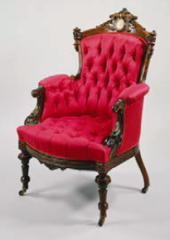
|
Ren Revival Arm Chair
-John Jelliff -Rosewood, ash mother of pearl
|
|
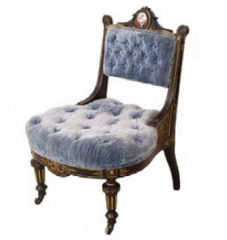
|
Ren Revival Side Chair
-tufted seat and back -incising -gilding -ebonized finish -italian ren and Louis XVI forms |
|
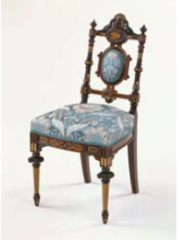
|
Ren Revival Side Chair
-Herter Brothers -Rosewood with marquetry of various woods and ivory -two front legs with iconic capitols
|
|
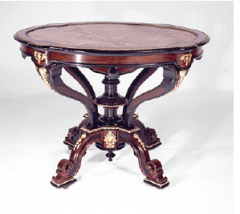
|
Ren Revival Side Table
-Pottier and Stymus -Rosewood with ebonized detailing and an inset oval rose with marble top, ormolu, egg and dart |
|

|
Semainier (seven drawer lingerie chest)
-Palissafer inlaid with Amaranth and Ivory -Ren Revival Furniture, French |
|
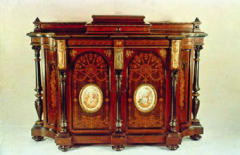
|
Drawing Room Cabinet
-Ren Revival-Neo Grec Influence -Alex Roux-cabinetmaker -Italian Ren and Greek, Roman and/or Egyptian Influences |
|

|
Cabinet: Ren Revival-Neo Grec Phase
-Alec Roux-cabinet maker -Rosewood, Tulipwood, Cherry, Poplar, Pine -Italian Ren and Greek, Roman and/or Egyptian Influences |
|

|
Ren Revival Bed
-Walnut -Angular Lines -Not flowing lines of Rococo |
|

|
New Louvre
-interior styles were Rococo Revival -Paris -Hector Lefuel and Louis Visconti -Second Empire Architecture |
|
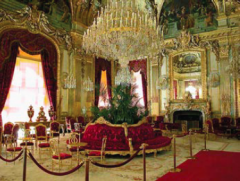
|
Grand Salon, Apartments Napoleon III
-Napoleon the 3rd wants to reunite France and incorporate symbols from the first empire and from previous Kings -Louvre -Second Empire |
|
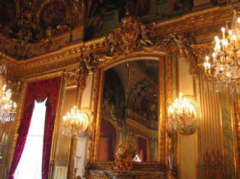
|
Grand Salon, Apartments Napoleon III
-Louvre
|
|
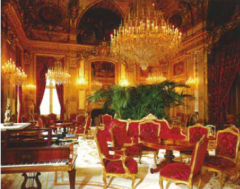
|
Grand Salon, Apartments Napoleon III
-Louvre |
|
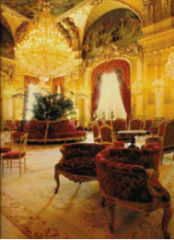
|
Indiscret
-Grand Salon, Apartments Napoleon III -Louvre -Second Empire, Paris |
|
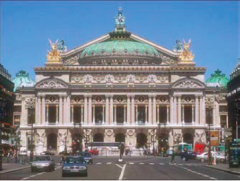
|
Palais Garnier (L'Opera de Paris)
-Charles Garnier -Second Empire -Paris |
|
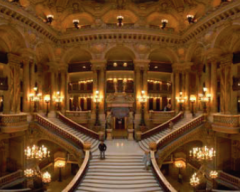
|
Grand Staircase, The Pailais Garnier (L'Opera de Paris)
-Second Empire -Paris -Charles Garnier |
|
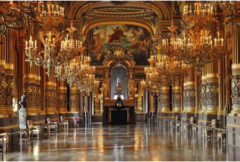
|
Grand Foyer, Palais Garnier (L'Opera de Paris)
-Charles Garnier -Second Empire -Paris
|
|
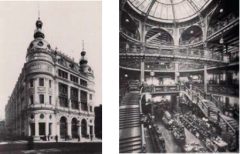
|
Les Grands Magasins du Printemps
-Paris -Second Empire |
|
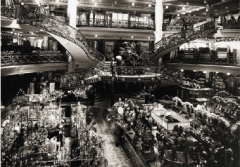
|
Au Printemps
-Paris |
|
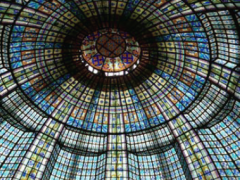
|
Au Printemps
-Paris -Second Empire |
|
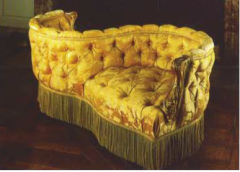
|
Confident
-Rococo Revival -French Second Empire |
|
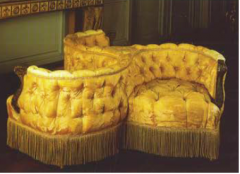
|
Indescret
-Rococo Revival -French Second Empire |
|
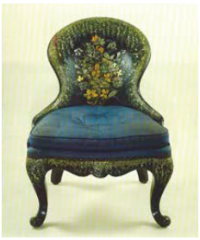
|
Papier Mache
-Rococo Revival -Inlaid with other of pearl and gold leaf -French Second Empire |
|
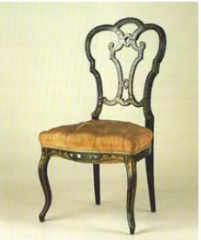
|
Chaise Legere
-Rococo Reevival -French Second Empire -Ebonized wood inlaid with mother of pearl and gold leaf
|
|
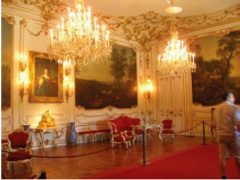
|
Imperial Apartment of Sisi and Franz Joseph
-Hofburg Palace, Vienna |
|
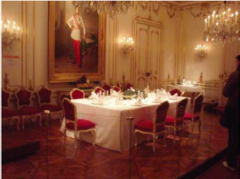
|
Imperial Apartment of Sisi and Franz Joseph
-Hofburg Palace, Vienna |
|

|
Rococo Revival Drawing Room
-New York -Belter Furniture
|
|
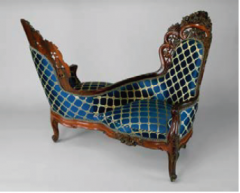
|
Tete-a-Tete
-Rococo Revival -New York -Belter |
|
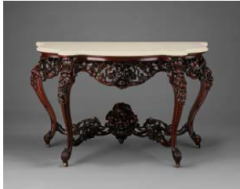
|
Rococo Revival Console Table
-New York -Belter |
|
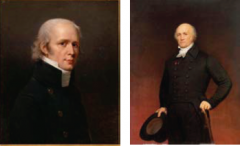
|
Percier and Fontaine
-defining architects of the French Empire period -formed a partnership with former royal furniture maker; Georges Jacob -one of their first private clients was Josephine Bonaparte, Napoleon's wife |
|
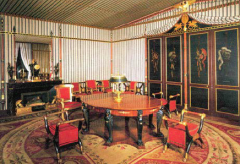
|
Council Chamber, Malmison
-Percier and Fontaine -French Empire -influenced by imperial Rome; Napoleon wanted to associate himself with Ceaser because he wanted to become the next big leader -Symbolizes Napoleon's military campaign; tent shape, very masculine |
|

|
Napoleon's Study Malmaison
-Percier and Fontaine -French Empire -emphasizes ceiling (domed) because the books lined the walls in the library which emphasizes the ceiling |
|
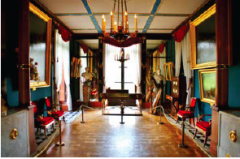
|
Music Room
-Chateau de Malmaison -French Empire -Percier and Fontaine |
|

|
Dining Room, Malmaison
-French Empire -black and white marble floors -walls inspired by frescos in Pompeii -Percier and Fontaine |
|
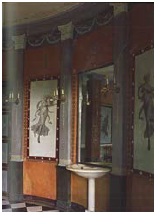
|
Dining Room, Malmaison
-French Empire -Percier and Fontaine -Roman Fourth Style Frescos provided inspiration for wall panels but illusionary architectural lines have been omitted -Percier and Fontaine use a French Empire star (6 pointed star rather than a 5 pointed star) as a rosette in a discontinuous linear pattern around the frame -modern take on Pompeii |
|

|
Josephine's Bedroom, Malmaison
-Percier and Fontaine -French Empire -1812 -Louis Berthaul-architect -done after Napoleon's second wife designed her room |
|
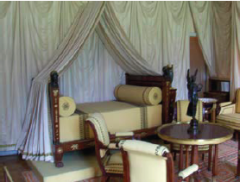
|
Napoleon's Bedroom, Malmaison
-French Empire -Percier and Fontaine -white decoration on walls was considered modern -textiles were important because they wanted to show wealth and power, but also because Napoleon was trying to revive the French textile industry |
|

|
Napoleon's Bed Detail, Malmaison
-French Empire -Percier and Fontaine -ormolu mounts |
|

|
Music Room, Hotel de Beauharnais
-French Empire -Percier and Fontaine -emphasis on the walls-influenced by Pompeii but expressed with a different color scheme |
|
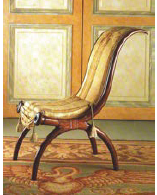
|
Chaise "Etrusque"
-Georges Jacob -Directoire Furniture -France -legs influenced by greek structures -simpler and smaller, and more slender proportions -elongated curve |
|
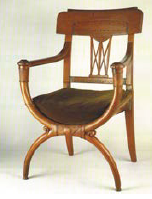
|
Fauteuil Curule
-Directoire Furnitue -France -Georges Jacob -legs influenced by greek structures -simpler and more slender proportions
|
|
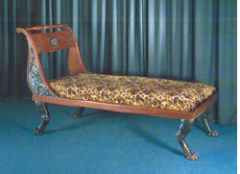
|
Recamier (daybed)
-curved back is a motif from Egypt-Sphinx -Bernard Molitor -Consulate Furniture |
|
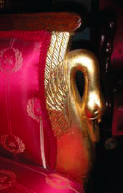
|
Pierre-Antoine Bellange
-Pierre-Antoine Bellange was the cabinetmaker for Percier and Fontaine. He carved many elaborate chair frames used at Malmaison invoking swans, gales, caryatids, sphinxes, and all manner of gilded referenced to imperial power and excess. -Chateau de Malmaison, Josephine's Bedroom -these were aligning Napoleon's regime with greatest civilizations of the past: Rome, Greece and Egypt. It was highly stylized and became an absolutely thorough way of branding the regime. Highly successful and imitated later by many other regimes including Napoleon III. -Laurel Wreath and Napoleonic Bee |
|
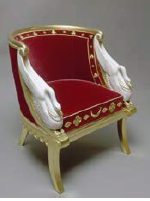
|
Gondola chair
-By Jacob Freres for perkier and Fontaine -Josephine's Bedroom , Saint-Cloud -Jacob Freres was the cabinetmaker who made this "Gondola Chair" carved with alarmingly literal swans wearing strings of golden pearls for Josephines boudoir at Saint-Cloud |
|
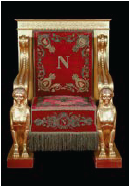
|
Napoleon's Throne
-masculine, blocky, sculptural and elaborate -"n" initial makes it personalized -Designer: Chalgrin, Cabinet Makers: Desmalter and Jacob -A sphinx with eagles' wings supports the structure. -Red Silk Velvet, gold thread embroidery
|
|
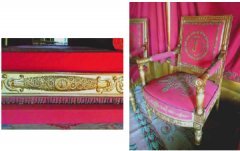
|
Josephine's Chair, Mailmaison
-initial personalizes it |
|
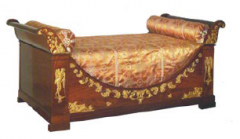
|
Empire Bed
-inspired by the Roman Lectus |
|
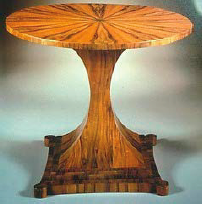
|
Biedermeier table
-beauty comes from wood veneer and clear finishes -Josef Danhauser -Austria |
|
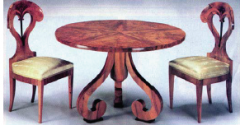
|
Biedermeier Furniture
-simple yet creative -Austria, Germany and Pruissa |
|
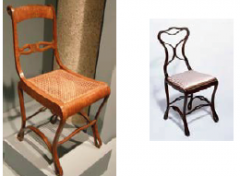
|
Bentwood Chair
-tried to make affordable furniture -laminated sheets of wood together heated them with steam and then bent them into shape -Michael Thronet -Germany and Austria |
|
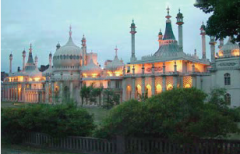
|
The Royal Pavilion at Brighton
-Chineese, Indian and Islamic influences -John Nash -English Regency
|
|
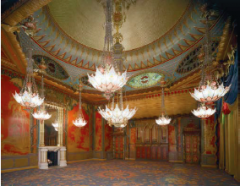
|
The Music Room, The Royal Pavilion at brighton
-John Nash and Frederick Crace -English Regency |
|
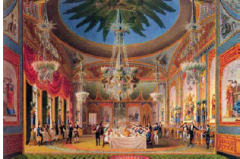
|
View of the Banqueting Hall or Dining Room, The Royal Pavilion
-John Nash -English Regency |
|
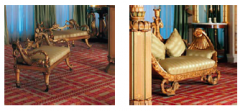
|
Dolphin Furniture
-new and unlike anything we had even seen before -John Nash and Frederick Crace -Banqueting hall Gallery, Royal Pavilion |
|
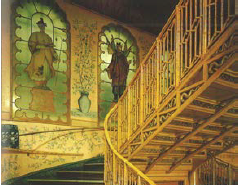
|
The Royal Pavilion at Brighton
-English Regency -Josh Nash and Frederick Crace -The faux bambou was made of cast iron, which was strong enough to make a thin and lacy staircase with very little visible means or support |
|
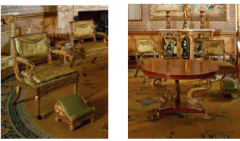
|
The Saloon, The Roya Pavilion at Brighton
-John Nash and Frederick Crace -English Regency |
|

|
Breakfast Room, Soane Residence
-John Soane-did a lot of designs for the middle class and a lot of experimentation -English Regency -London |
|
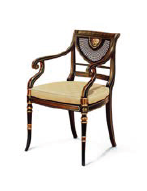
|
English Regency Armchair
-delicate with caning on the back (loose cushion on top) |
|

|
English Regency Armchair
-subtle curve on the back -ebonized finish with gilding |
|
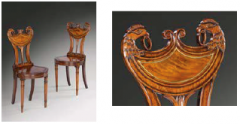
|
English Regency Hall Chair
-Mahagony with inlaid brass -London -influenced Biedermeier Designs (Biedermeier simplified it) |
|
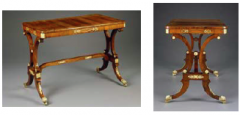
|
Sofa Table, English Regency
-long and rectangular, short enough to put behind a sofa -rosewood, inlaid brass and ormolu mounts -London |
|

|
Spider Leg Sofa Table, Classic English Regency Form
-rosewood with ormolu mounts -London -English Regency Furniture |
|
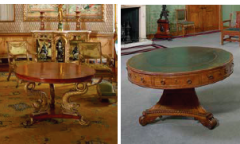
|
English Regency Pedestal Tables
-John Nash and Frederick Crace -The Royal Pavilion at Brighton |
|
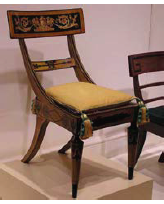
|
Painted Side Chairs, American Greek Revival
-not many are still around because they burned in a fire-the back leg was also not sturdy -Hugh and John Finlay Brothers of Baltimore
|
|
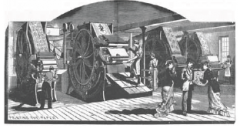
|
1820's Engraved Copper Cylinder
-Invented Industrial Wallpaper Printing Machine |
|
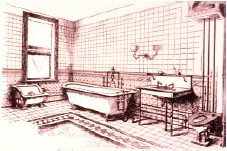
|
1890 Interior Water Pump and Water Closet |
|
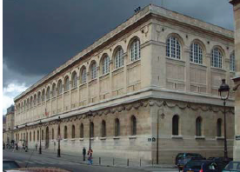
|
Bibliotheque Sainte Genevieve
-Labrouste-designer, top student -Paris Library -Neo-Grec Style -Paris |
|
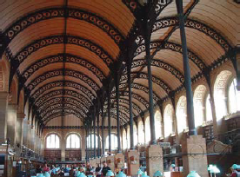
|
Pierre-Francois-Henri Labrouste, Bibliotheque Sainte Genevieve
-Paris -Cast iron as structure and ornament
|
|
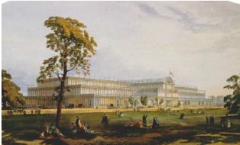
|
The Crystal Palace, London
-Joseph Paxton -used cast glass panels to construct buildings -designed for "great Exhibition of the Worlds of Industry of all Nations" |
|
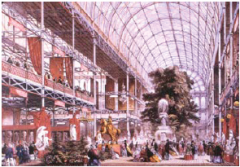
|
The Crystal Palace, London
-Joseph Paxton |
|

|
Reading Room
-many domes -paintings from Pompeii and cast iron ornament -Labrouste, Bibliotheque Nationale -Paris
|
|

|
The Eiffel Tower
-constructed for world wide exhibiton -Gustave Eiffel -Paris, 1889 |
|
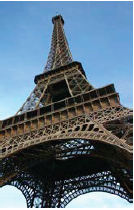
|
The Eiffel Tower
-Gustave Eiffel -Paris, 1889 |
|

|
Balloon Framing
-Other changes in construction techniques -Balloon frame versus heavy timber frame construction |
|
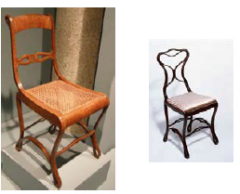
|
Bentwood Chair
-Michael Thornet -German Biedermeier |
|
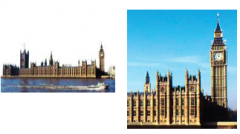
|
Palace of Westminster (Parliament)
-Pugin -London -Applying ecclesiastical style to government building |
|
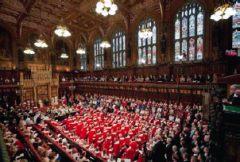
|
Palace of Westminster (Parliament) Interior
-Pugin -London |
|
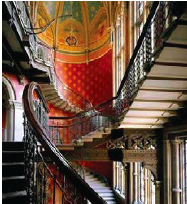
|
Midland Grand Hotel
-St. Pancras Station -London -Gothic Revival -(Harry Potter scene was filmed here) |
|
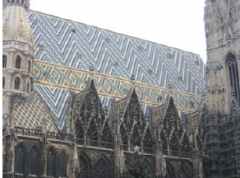
|
Late 19th Century Polychrome Roof, Gothic Revival
-multiple colors on one space -St. Stephens Cathedral, Vienna |
|
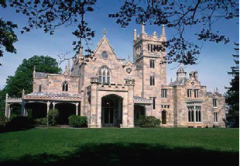
|
Lyndhurst
-Tarrytown, NY (remodel of 1838-42 house) -Alexander Jackson Davis-architect |
|
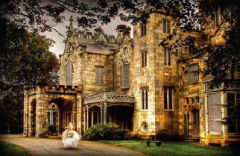
|
Lyndhurst
-Tarrytown, NY (remodel of 1838-42 house) -Alexander Jackson Davis-architect |
|
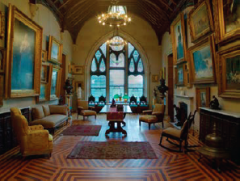
|
Picture Gallery, Lyndhurst
-AJ Davis -Painted Oak Floor -Gothic Revival |
|
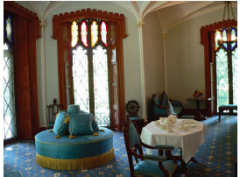
|
Restored Drawing Room, Lyndhust Villa
-Gothic Revival -AJ Davis, 20th C |
|

|
Wheelback Chair
-Gothic Revival Furniture -Lyndhurst Mansion -AJ Davis |
|
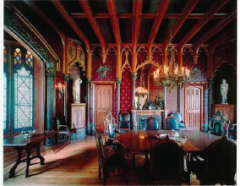
|
Dining Room, Lyndhurst
-Tarrytown, NY -Remodel, AJ Davis |
|
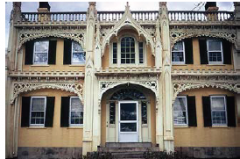
|
Carpenter Gothic-Decorative Vergeboard, Wedding Cake house
-Vergeboard: decorative wood that could now be cut and carved with machines-used on exteriors -Kennebunkport, George Washington Bourne |
|
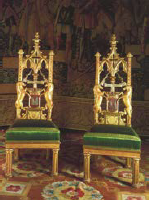
|
Jacob-Desmalter Chaises
-gilt wood -Paris |
|

|
Hall Chairs, Gothic Revival
-Walnut -Strong Museum in Rochester |
|

|
Gothic Revival Bench/Settee
-painted wood with caned seat -Sweden: simpler and focused more on craftsmanship
|
|
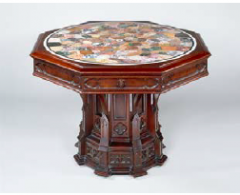
|
Center Table, Gothic Revival
-New York |
|
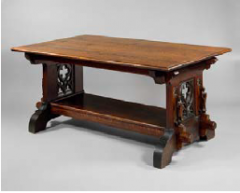
|
Library Table, Gothic Revival
-William Lightfoot Price -New York |
|
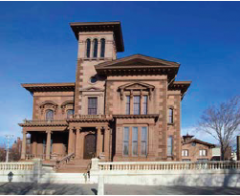
|
Morse Libby Mansion, Italianate
-Portland, Maine -Design influenced by Italian Venacular Farmhouses |
|

|
Reception Room Cabinet, Ren Revival
-Gustave Herter or Herter Bros, NY -Morse Libby Mansion, Portland Maine |
|
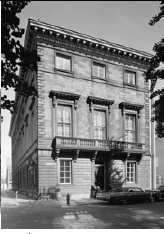
|
Anthenaeum, Ren Revival
-Philadalphia, PA -Design influenced by Italian Palazzos |

